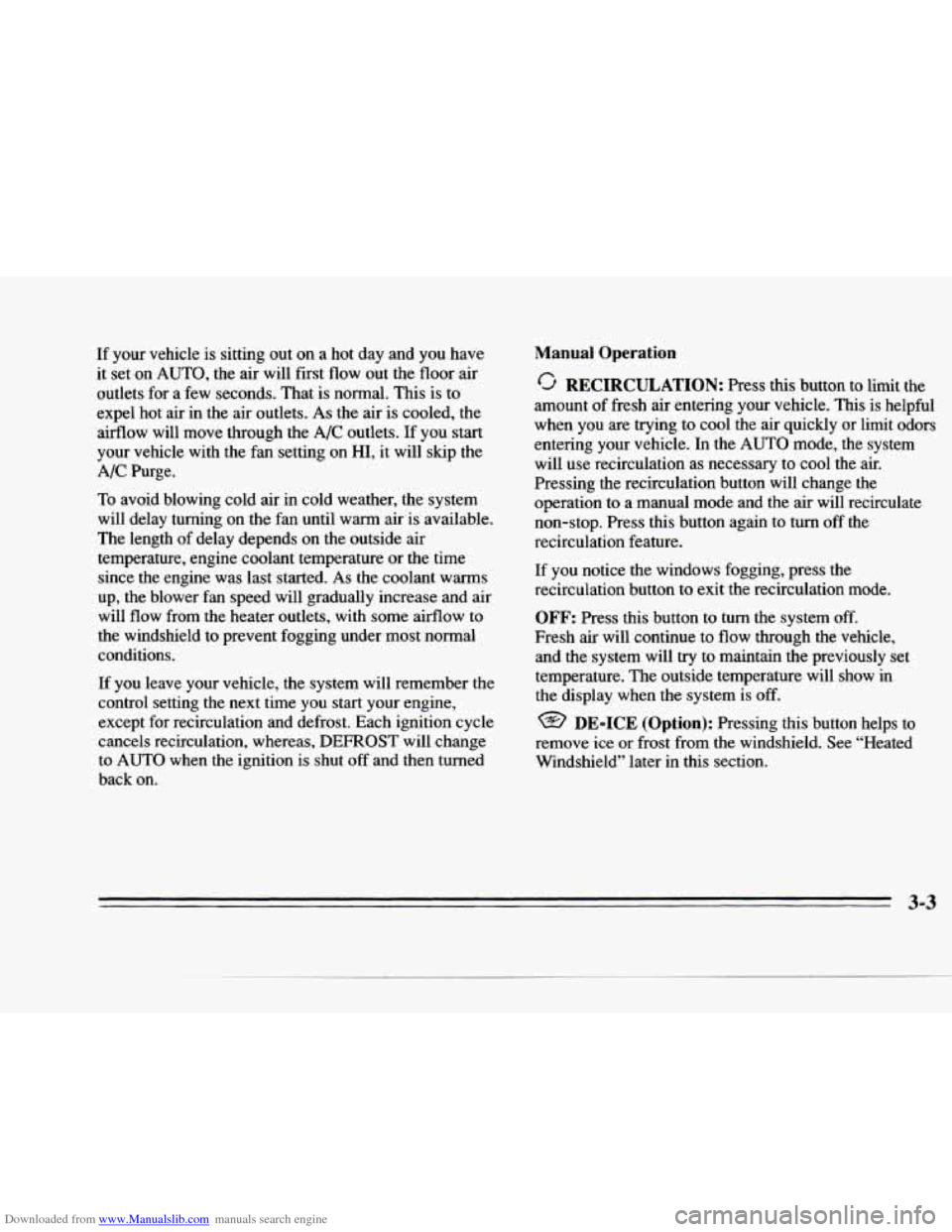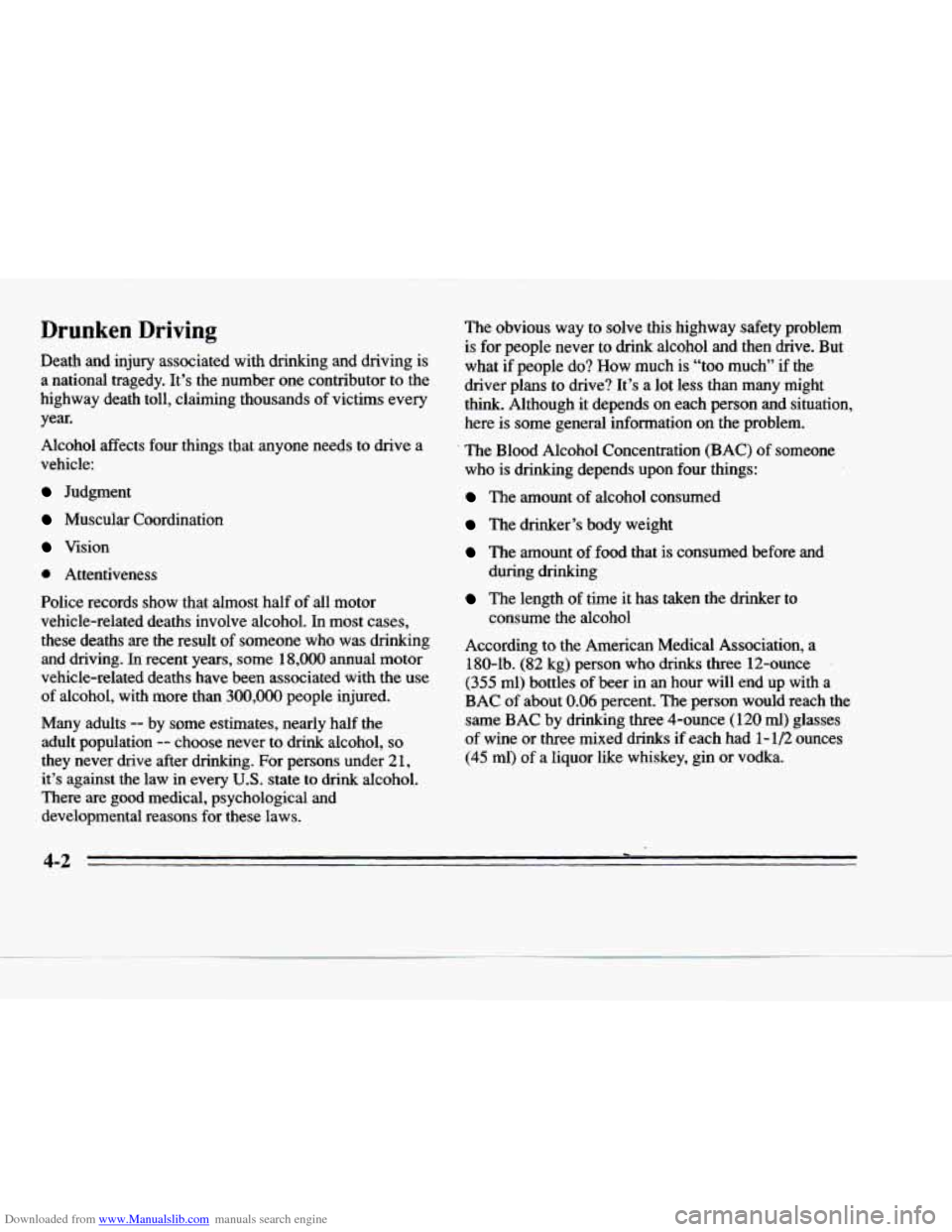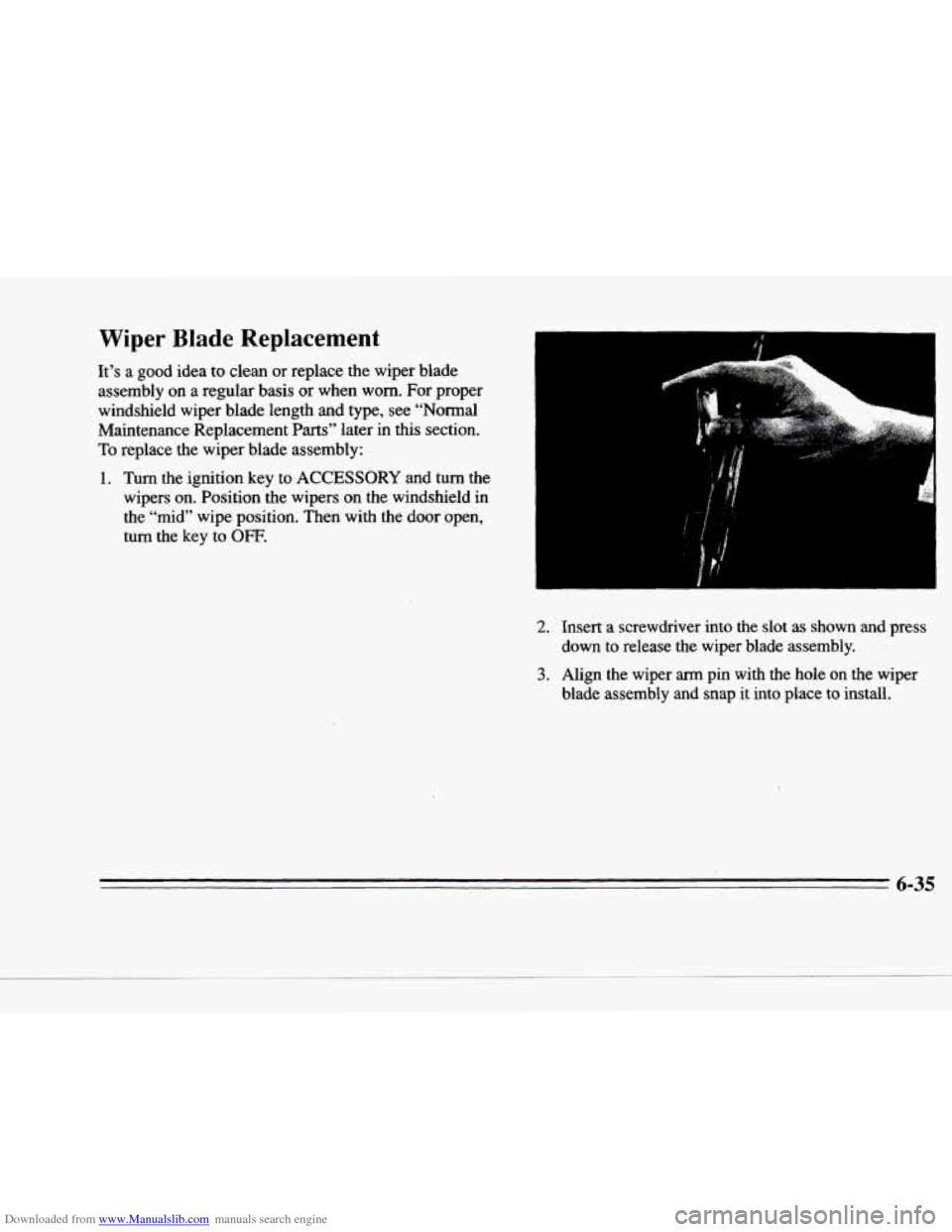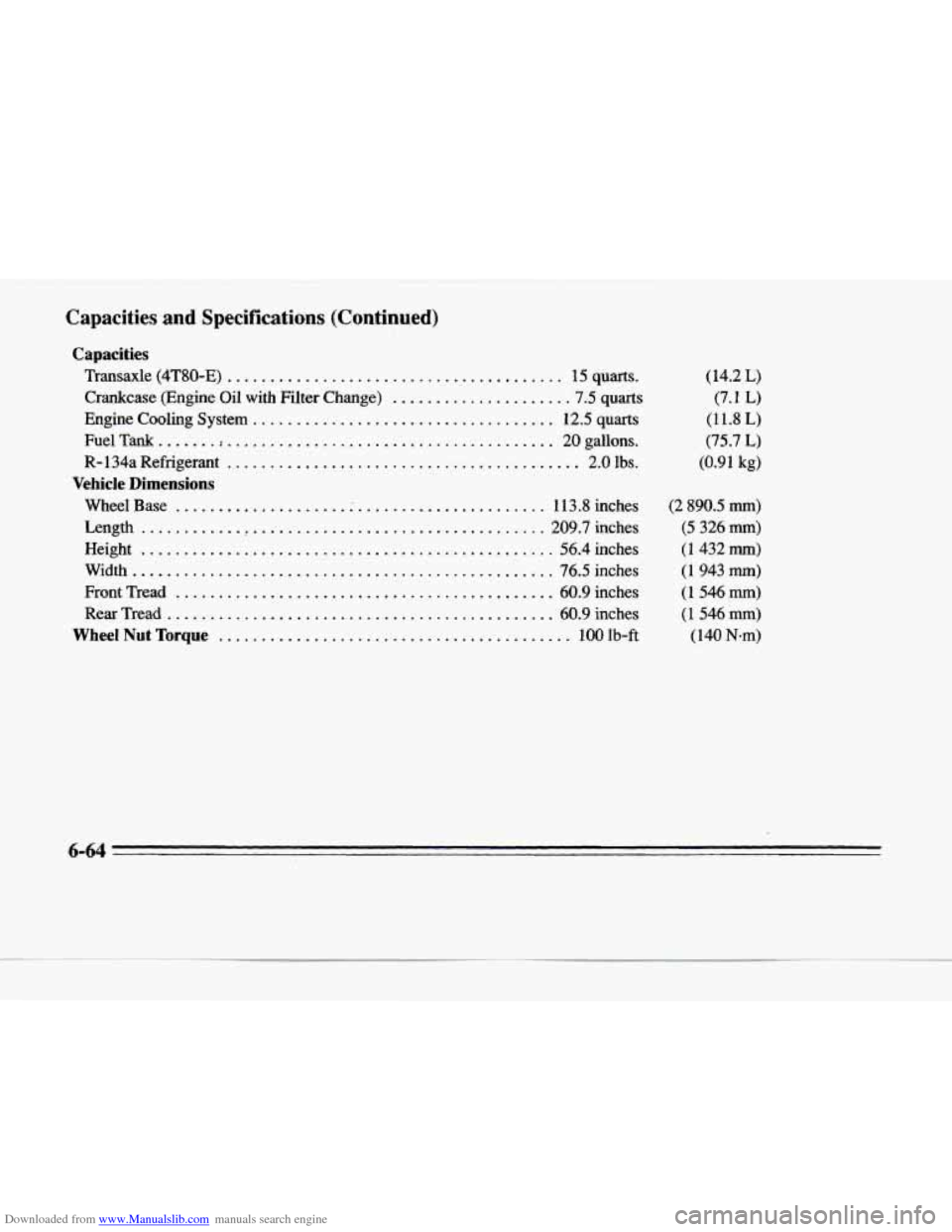length CADILLAC DEVILLE 1996 7.G Owners Manual
[x] Cancel search | Manufacturer: CADILLAC, Model Year: 1996, Model line: DEVILLE, Model: CADILLAC DEVILLE 1996 7.GPages: 354, PDF Size: 20.32 MB
Page 150 of 354

Downloaded from www.Manualslib.com manuals search engine P
c
c
If your vehicle is sitting out on a hot day and you have
it set -on
AUTO, the air will first flow out the floor air
outlets for a
few seconds. That is normal. This is to
expel hot air in the air outlets.
As the air is cooled, the
aifflow will move through the
A/C outlets. If you start
your vehicle with the fan setting on
HI, it will skip the
A/C Purge.
To avoid blowing cold air in cold weather, the system
will delay turning on the fan until warm air is available.
The length of delay depends on the outside air
temperature, engine coolant temperature or the time
since the engine was last started.
As the coolant warms
up, the blower fan speed will gradually increase
and air
will flow from the heater outlets, with some aifflow to
the windshield to prevent fogging under most nonnal
conditions.
If you leave your vehicle, the system will remember the
control setting
the next time you start your engine,
except for recirculation and defrost. Each ignition cycle
cancels recirculation, whereas,
DEFROST will change
to
AUTO when the ignition is shut off and then turned
back on.
Manual Operation
RECIRCULATION: Press this button to limit the
amount of fresh air entering your vehicle. This is helpful
when you are trying to cool the air quickly or limit odors
entering your vehicle. In the
AUTO mode, the system
will use recirculation as necessary to cool the air.
Pressing the recirculation button will change the
operation to a manual mode and the air will recirculate
non-stop. Press this button again to
turn off the
recirculation feature.
If you notice
the windows fogging, press the
recirculation button
to exit the recirculation mode.
OFF: Press this button to turn the system off.
Fresh air will continue to flow through the vehicle,
and the system will try
to maintain the previously set
temperature. The outside temperature will show in
the display when the system is off.
@ DE-ICE (Option): Pressing this button helps to
remove ice or frost from the windshield. See "Heated Windshield" later in this section.
Page 183 of 354

Downloaded from www.Manualslib.com manuals search engine Drunken Driving
Death and injury associated with drinking and driving is
a national tragedy. It’s the number one contributor to the
highway death toll, claiming thousands of victims every
year.
Alcohol affects four things that anyone needs to drive a
vehicle:
Judgment
Muscular Coordination
Vision
0 Attentiveness
Police records show that almost half of all motor
vehicle-related deaths involve alcohol. In most cases, these deaths are the result
of someone who was drinking
and driving.
In recent years, some 18,000 annual motor
vehicle-related deaths have been associated with the use
of alcohol, with more than
300,000 people injured.
Many adults
-- by some estimates, nearly half the
adult population
-- choose never to drink alcohol, so
they never drive after drinking. For persons under 21,
it’s against the law in every U.S. state to drink alcohol.
There
are good medical, psychological and
developmental reasons for these laws. The obvious way
to solve this highway safety
problem
is for people never to
drink alcohol and then drive. But
what if people do? How much is “too much” if the
driver plans to drive? It’s a lot less
than many might
think. Although
it depends on each person and situation,
here is some general information on the problem.
The Blood Alcohol Concentration
(BAC) of someone
who is drinking depends upon four things:
The amount of alcohol consumed
The drinker’s body weight
The amount of food that is consumed before and
during drinking
consume the alcohol
The length of time it has taken the drinker to
According to the American Medical Association,
a
180-lb. (82 kg) person who drinks three 12-ounce .
(355 ml) bottles of beer in an hour will end up with a
BAC of about 0.06 percent. The person would reach the
same BAC by drinking three 4-ounce
(120 ml) glasses
of wine or three mixed drinks if each had
1-1/2 ounces
(45 ml) of a Iiquor like whiskey, gin or vodka.
4-2 -
Page 296 of 354

Downloaded from www.Manualslib.com manuals search engine 1c
i
Wiper Blade Replacement
It’s a good idea to clean or replace the wiper blade
assembly on a regular basis or when worn. For proper
windshield wiper blade length and type, see
“Normal
Maintenance Replacement Parts” later in this section.
To replace the wiper blade assembly:
1. Turn the ignition key to ACCESSORY and turn the
wipers on. Position the wipers on the windshield
in
the “mid” wipe position. Then with the door open,
turn the key to
OFF.
2. Insert a screwdriver into the slot as shown and press
down to release the wiper blade assembly.
3. Align the wiper arm pin with the hole on the wiper
blade assembly and snap it into place to install.
6-35
Page 325 of 354

Downloaded from www.Manualslib.com manuals search engine Capacities and Specifications (Continued)
Capacities
Transaxle (4T80-E) ....................................... 15 quarts.
Engine Cooling System
................................... 12.5 quarts
R- 134a Refrigerant ......................................... 2.0 lbs.
Crankcase (Engine Oil with Filter Change) .................... .7.5 quarts
FuelTank ....... ....................................... 20gallons.
Vehicle Dimensions
Wheel Base .................... ; ...................... 113.8 inches
Length
............................................... 209.7inches
Height
................................................ 56.4 inches
Wid
................................................... 76.5inches
Front Tread ............................................ 60.9 inches
Rear Tread ............................................. 60.9 inches
Wheel Nut Torque ......................................... 100 lb-ft (14.2
L)
(7.1 L)
(11.8 L)
(75.7 L)
(0.91 kg)
(2 890.5 mm)
(5 326 mm)
(1 432 mm)
(1 943 mm)
(1 546 mm)
(1
546 mm)
(140 Nm)
-.
6-64